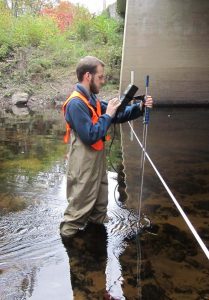Student Helping to Unlock Mysteries of Watersheds
 Watersheds still contain many mysteries. For example: how, specifically, does water pick up harmful bacteria as it flows toward its destination? And what factors within particular streams, rivers or lakes help filter out bacteria before water reaches its outlet?
Watersheds still contain many mysteries. For example: how, specifically, does water pick up harmful bacteria as it flows toward its destination? And what factors within particular streams, rivers or lakes help filter out bacteria before water reaches its outlet?
Graduate student Brian Van Dam has been researching and mapping the Gulf of Maine watershed and early indicators point to wetlands as a potential filtering factor.
“Early results suggest that the presence of wetlands in our watersheds may correlate significantly with lower bacteria levels near the watershed outlets, so that is one factor that we’ll be keeping an eye on going forward,” Van Dam said.
Van Dam is a master’s student in UMaine’s School of Earth and Climate Sciences and the Senator George J. Mitchell Center for Sustainability Solutions. He is also a graduate research assistant on the New England SusTainability Consortium (NEST) Safe Beaches & Shellfish project. He’s part of a team investigating how watershed characteristics on land affect bacteria levels in coastal waters after rain events. See more here
